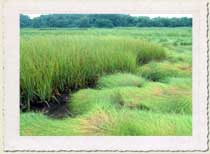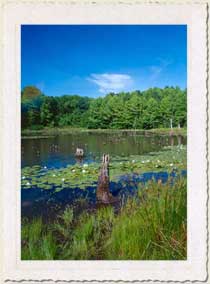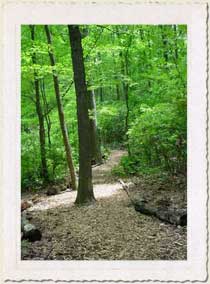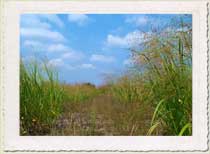
Forever Wild:
Urban Ecosystems
An ecosystem is a group of plants and animals that interact with one another and their environment, such as a wetland, a forest, or a meadow. New York City's Forever Wild Nature Preserves provide a home for native plants and wildlife, including both federal and state-protected flora and fauna. They are also rest stops for a great number of migrating birds each spring and fall.
Wetlands
There are many types of wetlands in New York City, ranging from tranquil swamp forest to surf-pounded coastal shoreline. Nearly half of present day New York City was once either saltwater or freshwater wetland, but as the city expanded, many wetlands were filled in and lost.
Salt Marsh
A salt marsh has three distinct zones: mud flat, low marsh, and high marsh. The seemingly barren mudflats, exposed only at low tide, teem with creatures like fiddler crabs, mud snails, and marine worms. These invertebrates (animals without a backbone) provide food for the birds, mammals, and fish that live in the marsh. Growing between mid-tide and high-tide is salt marsh cordgrass (Spartina alterniflora), the only plant that grows in the low marsh.
Spartina has a mutual relationship with the fiddler crabs and mussels that live in the low marsh. While feeding amongst Spartina's roots, the fiddler crabs' burrowing aerates the roots, providing essential oxygen, while the mussels' nutrient-rich waste provides Spartina with nitrogen. Furthermore, mussels accumulate heavy metals and toxins in their shells, naturally reducing pollution levels in our waters. The high marsh is immersed only in the highest tides of the month (called spring tides), and the plants growing there are less tolerant of salt than Spartina. Saltmeadow cordgrass (Spartina patens) is the dominant high marsh plant and can be easily identified by the way wind and water swirl its tender stems into ridges that resemble cowlicks.
Freshwater Wetlands
Freshwater wetlands teem with plant and animal life, and wetland vegetation occurs in well-defined zones, according to water depth. Duckweed and water lilies float on the water's surface; algae and coontail live just below it; pickerelweed and bulrush emerge at the water's edge; and reeds, rushes, and young red maples signal the subtle transformation from wetland to wet meadow to woodland.
There are three major wetland groups: marshes, swamps, and bogs. Bogs form around watertight, rain-fed basins, usually kettlehole ponds left by glaciers. They support a unique group of plants and animals that are too fragile to have survived the stresses of development; New York City's bogs have been nearly wiped out. Marshes are characterized by soft-stemmed (herbaceous) plants like arrow arum, cattails, and rushes, while swamps are home to water-loving woody plants like buttonbush, spicebush, sweet gum, and white ash. Protection of freshwater wetlands is critical because in addition to providing a home to rare and beautiful plants and animals, they are also provide natural flood control, help control erosion, and filter water.
Forests
New York City's forests and woodlands are remarkably diverse. Although the words forest and woodland are often used interchangeably, they actually mean different things. A woodland is open with space between the treetops that allows enough sun to penetrate to sustain a rich understory of shrubs, vines, and herbaceous plants. A forest's thick canopy, on the other hand, permits little light to filter to the ground below. A forest is made up of four different layers: the canopy layer, the shrub layer, the understory, and the ground layer. Each layer is home to a distinct set of plants and animals that have adapted to form an intricate vertical structure where the finely-tuned timing of leaf emergence and flowering allow spring ephemerals—such as bloodroot, mayapple, and trout lily—to thrive beneath towering trees, such as red oaks, bitternut hickory, and tulip trees.
Within the five boroughs you can find floodplain forest, red maple-hardwood swamp, oak-hickory forest, rich forest, and successional forest. Check out the Forever Wild Nature Preserve Sites page to learn more about specific forests.
Meadows
Meadows are sunny, open spaces filled with grasses and wildflowers. Butterflies float over the meadow's grasses and birds of prey—red-tailed hawks and barred, screech, and great-horned owls—hunt mice and voles that live in the meadow. Though meadows are relatively rare in New York City, their plant and animal diversity is astounding. Wet meadows support a variety of rushes (recognizable by their round stems) and sedges (recognizable by triangular stems), while drier meadows sustain tall stands of switchgrass, little bluestem, and broom sedge, amongst other species. Unless meadows are maintained by natural or human forces, shrubs and trees colonize, eventually transforming the area into woodland. This change in species composition is called "succession."



